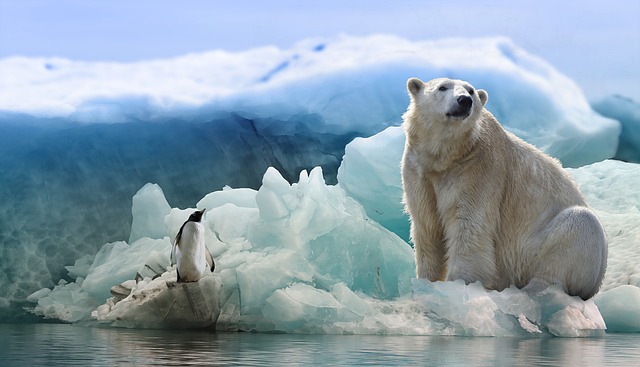Climate change, the long-term shift in global temperatures and weather patterns, stands as one of the most pressing challenges confronting humanity today. Primarily driven by the increasing concentration of greenhouse gases in the atmosphere due to human activities such as the burning of fossil fuels and deforestation, climate change is no longer a distant threat but a stark reality unfolding before our eyes. Its impacts are far-reaching, affecting every corner of the globe and touching upon every aspect of human society and the natural world.
Rising Temperatures and Extreme Weather Events
The planet’s average temperature has been steadily rising, with the last decade (2011-2020) being the warmest on record, according to the Intergovernmental Panel on Climate Change (IPCC). This upward trend, primarily attributed to the burning of fossil fuels for energy and transportation, is fueling a surge in extreme weather events. Heatwaves are becoming more frequent, intense, and prolonged, as witnessed in the scorching summers experienced across Europe and North America in recent years. These heatwaves not only pose significant risks to human health, leading to heatstroke, dehydration, and respiratory problems, but also exacerbate droughts, wildfires, and strain energy grids, leading to power outages and economic disruptions.
Intensifying Storms and Hurricanes
Climate change is also altering atmospheric patterns, intensifying storms and hurricanes. Warmer ocean temperatures provide more energy for these storms, leading to higher wind speeds, increased rainfall, and greater destructive potential. The devastating hurricanes that have battered coastal regions in recent years, leaving a trail of destruction and displacement in their wake, serve as stark reminders of the escalating risks posed by a warming world. For example, the 2017 Atlantic hurricane season, which saw powerful storms like Harvey, Irma, and Maria, caused unprecedented damage and displacement, highlighting the vulnerability of coastal communities to the impacts of climate change.
Impacts on Ecosystems and Biodiversity
The natural world is bearing the brunt of climate change. From the icy poles to the lush rainforests, ecosystems are undergoing rapid transformations, threatening the delicate balance of life on Earth. Coral reefs, vital marine ecosystems teeming with biodiversity, are facing an existential crisis due to ocean acidification, a process driven by the absorption of excess carbon dioxide from the atmosphere, and rising water temperatures. These stressors lead to coral bleaching, a phenomenon where corals expel the symbiotic algae that provide them with food, making them more susceptible to disease and death. The loss of coral reefs has devastating consequences for marine biodiversity, fisheries, and coastal protection.
Forest Vulnerability
Forests, crucial carbon sinks that help regulate the Earth’s climate by absorbing carbon dioxide from the atmosphere, are increasingly vulnerable to wildfires, pests, and diseases, further accelerating climate change. Rising temperatures and changes in precipitation patterns create drier conditions that make forests more susceptible to wildfires, releasing massive amounts of carbon dioxide into the atmosphere and further exacerbating climate change. Additionally, warmer temperatures allow pests and diseases to spread to new areas, damaging forests and reducing their ability to absorb carbon dioxide.
Social and Economic Impacts
Climate change is a profound social and economic challenge that threatens to undermine decades of development progress and exacerbate existing inequalities. The impacts are felt most acutely by the world’s poorest and most vulnerable communities, who often lack the resources to adapt to the changing climate and are disproportionately exposed to its risks. Heat-related illnesses and mortality are on the rise, particularly among the elderly, children, and those with underlying health conditions, straining healthcare systems and exacerbating existing health disparities. Climate change can also exacerbate the spread of infectious diseases, as warmer temperatures and altered precipitation patterns create more favourable conditions for disease vectors, such as mosquitoes that transmit malaria and dengue fever.
Threats to Food Security and Water Resources
The threats to food security and water resources are particularly alarming, with the potential to lead to widespread hunger, displacement, and conflict. Climate change is already impacting crop yields and livestock production in many regions, leading to food shortages, price spikes, and increased hunger, particularly in low-income countries that are highly dependent on agriculture. Water scarcity is becoming a pressing concern, as droughts intensify and glaciers, vital sources of freshwater for billions, continue to melt at an alarming rate. Competition for scarce water resources can exacerbate tensions between communities and even lead to conflict.
The economic costs of climate change are staggering, with the potential to disrupt global markets and undermine economic stability. Extreme weather events cause billions of dollars in damage to infrastructure, disrupt supply chains, and lead to lost productivity, impacting businesses, insurance companies, and governments. Climate change also poses significant risks to insurance and financial markets, as the costs of insuring property in high-risk areas increase and investors become more wary of investing in companies with high carbon footprints. The displacement of millions of people due to sea-level rise, extreme weather events, and resource scarcity is creating a humanitarian crisis and fuelling social unrest, putting additional strain on resources and exacerbating existing inequalities.
Conclusion
Mitigating climate change by reducing greenhouse gas emissions through a rapid transition to renewable energy sources, improved energy efficiency, and sustainable land management practices is paramount. This requires a fundamental shift in our energy systems, transportation networks, and consumption patterns, embracing innovative technologies and sustainable practices. Equally crucial is investing in adaptation measures to build resilience to the impacts that are already occurring and will continue to intensify in the coming decades. This includes investing in climate-resilient infrastructure, developing early warning systems for extreme weather events, and implementing sustainable water management practices.




